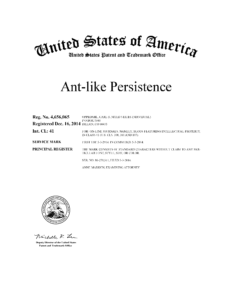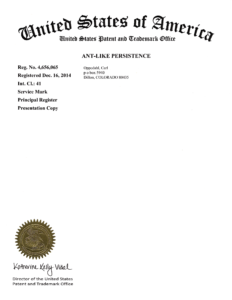

As I explain in this blog article, “presentation copies” from the USPTO are not very good from a “suitability for framing” point of view. But what is much worse is that “presentation copies” are going to cause harm to the trademark community. The Trademark Office’s recent spotlight on “presentation copies”, and indeed the Trademark Office’s recent program of giving them away for free, will very predictably embolden some trademark owners in overstating the breadth of their trademark rights. The Trademark Office will be aiding and abetting the intimidation of parties who are not actually doing anything wrong but who are the target of overly broad cease-and-desist letters.
By way of background, recently the Trademark Office discontinued the provision of physical trademark registration certificates. Nowadays the trademark registrant is given a mere electronic registration certificate, which is not particularly suitable for framing. Regrettably, even though it would be easy to do, in its electronic registration certificates, the Trademark Office does not even try to provide a gold-colored replica of the familiar gold seal. But the Trademark Office says that for those who were given a mere electronic registration certificate, and want something suitable for framing, the consolation prize is the “presentation copy”, one of which will be provided free of charge if the filing date of the underlying trademark application is prior to May 24, 2022.
You might wonder whether a “presentation copy” is any good. I think it is not much good in terms of its “suitability for framing”. You can see, above, an actual physical registration certificate (click to enlarge) and the “presentation copy” thereof (also click to enlarge). I think the “presentation copy” is an embarrassment. It is mostly blank! Mostly empty!
Yes, it has an actual gold seal. But the vastness of the blank area in the middle of the document is exacerbated by the positioning of the top matter, smashed up as it is against the top edge of the document. (The real certificate has a sort of normal top margin, leading to a more balanced vertical positioning of text.) Further exacerbating the vastness of the blank area in the middle of the document is the unaccountable decision by the Trademark Office to reproduce the mark in the presentation copy in a much smaller point size compared with the point size of the mark as it appears in the registration certificate. The mark in the presentation copy is about 40% smaller in height and width compared with the mark in the registration certificate.
If you were to frame this presentation copy, and hang it on a wall, and if you were to stand back to a normal viewing distance, you would have to squint to try to make out the actual text of the mark.
Other deficiencies in the presentation copy include its failure to list dates of first use and its failure to show the application filing date. If there is a disclaimer, it will be missing and other important information is also missing.
The presentation copy wrongly reproduces the drawing of the mark. In this case, the drawing had upper-case and lower-case letters, as may be seen in the registration certificate. But the presentation copy substitutes all capital letters for the upper-case and lower-case letters in the actual drawing of the mark. The mark is actually in a Times New Roman font, but unaccountably the presentation copy uses a very different font.
Think how often we as practitioners have had to explain to our clients, and indeed to the writers of cease-and-desist letters directed at our clients, that a US trademark registration does not provide “rights in gross” as to all possible goods and services. One of the most insidious things, then, about these “presentation copies” is that for no good reason, they omit any listing of the goods and services. This will surely cause harm to the trademark community in at least two ways:
-
- Many members of the trademark community who already had gotten a mistaken impression that what the USPTO grants are “rights in gross” will be reinforced in this mistaken impression every time they see one of these “presentation copies”.
- A writer of a cease-and-desist letter will use the “presentation copy” rather than the actual certificate, hoping to give the impression to the recipient of the letter that what the USPTO granted was indeed “rights in gross”.
The writer of the cease-and-desist letter will likewise delight in the opportunity to avoid mention of a disclaimer, thus in a second and distinct way leaving the recipient of the letter with a deceptively broad impression of the rights possessed by the registrant.
You will also note that the name of the signer sort of does not make sense. The registration above was granted at a time when Michelle Lee was the Director, and thus it is signed by her. But the “presentation copy” is not signed by Michelle Lee.

Another oddity, which I just noticed: I used TESS to find a registration issued yesterday. I picked the first one in the TESS list (6782557), went to TSDR, opened the registration certificate in the viewer, then downloaded it from the viewer to a PDF file. That’s the only way to get the full registration certificate complete with the signature data at the top. To my surprise, it’s an A4 page, not a letter-size page. Are the presentation copies also on A4 paper? or are they on letter-sized paper? If I download the same certificate from the documents page of TSDR directly, it’s a letter-sized file with smaller margins.
In addition, the two different files were created not only by two different versions of the iText software: the signed version has a PDF producer of “iText 5.5.15-SNAPSHOT ©2000-2018 iText Group NV (AGPL-version); modified using iText 5.5.15-SNAPSHOT ©2000-2018 ” and is PDF version 1.7, Adobe Extension Level 5 (Acrobat 9.x), while the unsigned version has a PDF producer of “iText 2.1.7 by 1T3XT” and is PDF version 1.4 (Acrobat 5.x).
I wonder if the presentation copies are printed from the signed version of the file and shrunk/trimmed to fit onto letter-size paper. We’ll probably never know, because the PTO won’t want to say.
In answer to your question, the two “presentation copies” that I have received are each 8½ inches by 11.